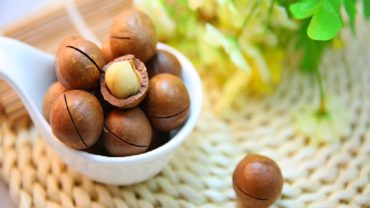via Kiddle: The macadamia nut is the fruit of a tree that first came from the east coast of Australia. There is more than one kind of Macadamia tree. Only one kind is grown for food.
The tree is an evergreen (stays green all year long). It grows up to 25 feet (7.6 metres) high. It has groups of small white flowers. It grows best in subtropical (wet and always warm) climates. It needs well-drained soil (water can flow away easily) and 40 to 100 inches (1,000 to 2,500 mm) of rain a year.
The nutmeat (the soft part inside the shell that can be eaten) is mostly a creamy white color. Sometimes it looks a bit yellow. It has a flavor that many people like. Macadamias are eaten roasted (cooked) by themselves. They are used in cookies, cakes, pastries, and candies. People use them like almonds and cashews as part of cooked meals. This is an Oriental style of cooking.
The first commercial orchard was started in Australia in the late 1880s. Commercial production started in Hawaii during the 1920s. Production later spread to California, Mexico, and other places with warm climate.
Macadamias are poisonous to dogs. A dog usually needs 24 to 48 hours to recover fully after eating macadamias.The plant is in the Proteaceae family of flowering plants.
Description
Macadamia is an evergreen genus that grows 2–12 m (7–40 ft) tall.
The leaves are arranged in whorls of three to six, lanceolate to obovate or elliptic in shape, 6–30 cm (2–10 in) long and 3–13 cm (1–5 in) broad, with an entire or spiny-serrated margin. The flowers are produced in a long, slender, simple raceme 5–30 cm (2–10 in) long, the individual flowers 10–15 mm (0.4–0.6 in) long, white to pink or purple, with four tepals. The fruit is a hard, woody, globose follicle with a pointed apex, containing one or two seeds.
History
1828
Allan Cunningham was the first European to discover the macadamia plant.
1857
German-Australian botanist Ferdinand von Mueller gave the genus the scientific name Macadamia – named after von Mueller’s friend Dr. John Macadam, a noted scientist and secretary of the Philosophical Institute of Australia.
1858
Walter Hill, superintendent of the Brisbane Botanic Gardens (Australia), observed a boy eating the kernel without ill effect, becoming the first nonindigenous person recorded to eat macadamia nuts.
1860s
King Jacky, aboriginal elder of the Logan River clan, south of Brisbane, Queensland, was the first known macadamia entrepreneur, as his tribe and he regularly collected and traded the macadamias with settlers.
1866
Tom Petrie planted macadamias at Yebri Creek (near Petrie) from nuts obtained from Aboriginals at Buderim; 1882
William H. Purvis introduced macadamia nuts to Hawaii as a windbreak for sugar cane.
1888
The first commercial orchard of macadamias was planted at Rous Mill, 12 km from Lismore, New South Wales, by Charles Staff.
1889
Joseph Maiden, Australian botanist, wrote, “It is well worth extensive cultivation, for the nuts are always eagerly bought.”
1910
The Hawaiian Agricultural Experiment Station encouraged planting of macadamias on Hawaii’s Kona District, as a crop to supplement coffee production in the region.
1916
Tom Petrie begins trial macadamia plantations in Maryborough, Queensland, combining macadamias with pecans to shelter the trees.
1922
Ernest Van Tassel formed the Hawaiian Macadamia Nut Co in Hawaii.
1925
Tassel leased 75 acres (30 ha) on Round Top in Honolulu and began Nutridge, Hawaii’s first macadamia seed farm.
1931
Tassel established a macadamia-processing factory on Puhukaina Street in Kakaako, Hawaii, selling the nuts as Van’s Macadamia Nuts.
1937
Winston Jones and J. H. Beaumont of the University of Hawaii’s Agricultural Experiment Station reported the first successful grafting of macadamias, paving the way for mass production.
1940s
Steve Angus, Murwillumbah, Australia, formed Macadamia Nuts Pty Ltd, doing small-scale nut processing.
1946
A large plantation was established in Hawaii.
1953
Castle & Cooke added a new brand of macadamia nuts called “Royal Hawaiian”, which was credited with popularizing the nuts in the U.S.
1997
Australia surpassed the United States as the major producer of macadamias.
2012–15
South Africa surpassed Australia as the largest producer of macadamias.
2014
Macadamia nuts were responsible for the delay of Korean Air Flight 86 at John F. Kennedy International Airport in New York City. This “nut rage incident” gave the nuts high visibility in the South Korean economy and marked a sharp increase in consumption there.


